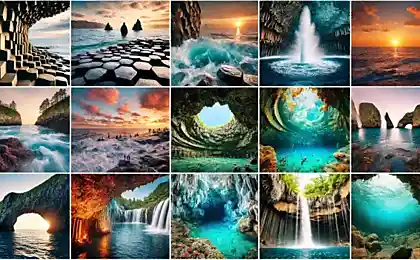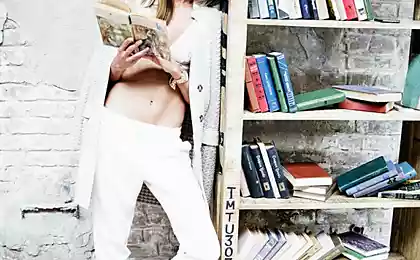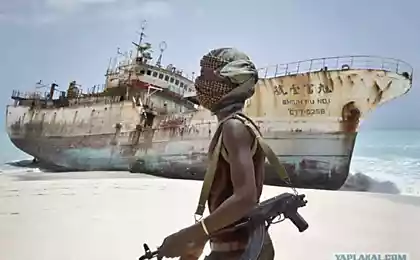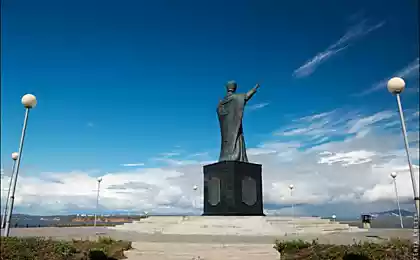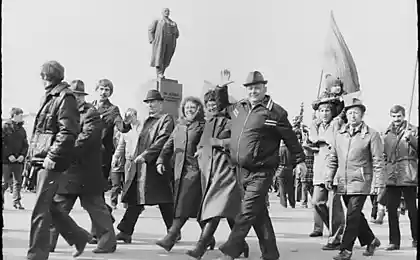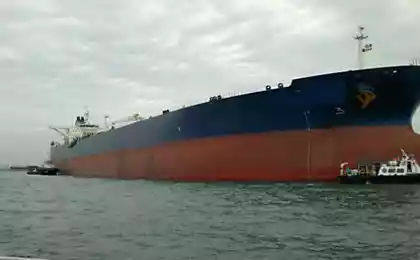678
Staffa, Fingal's patrimony
Writes estranic:
Staffa (translated from the Norse "island of the columns") - a volcanic island in the inner Hybrid.
For the general public stuff "discovered" in the 18th century, the famous naturalist, botanist and social activist Sir Joseph Banks, who compared the island basalt columns with the Louvre in Paris and Rome Cathedral of St. Peter - and not in favor of the latter.
Modern Britain is rightly took stuff in the top ten most beautiful places in the UK.
And I, in turn, am quite sure that this is an alien base which aliens do not even bother to disguise as it should. But judge for yourself.

2. Base aliens positioned very strategically: ten kilometers from the large neighboring island Mule. On the one hand - close to the populated areas, if you suddenly want to take a walk around the shops. On the other - it is still 10 km away from the sea of the rolled routes. Even today, the island is only accessible by a calm sea - what happens in these parts very often. Throw invariably hideous weather, squally winds with gusts to 100 km / h and the lack of places for berthing. It is not surprising that the last inhabitants fled the island already in the 18th century: it is difficult to live permanently on the land the size of a nickle some 30 hectares, which does not cease roar starters plates absent himself from which you can, at best, a couple of months a year.
In the absence of the local population aliens built wide: from the base of a dozen entrances, disguised as a cave. The most famous of them - Fingal's Cave, so named not only because visitors often slips in it (which is also true), but in honor of the giant Fingal (which is probably also not in vain so named), the hero gellskogo and Irish epic. Fingal's Cave (pictured below) - the only one to which few visitors to the island can be reached on foot along a narrow path of the broken off hexagonal pillars (pictured above). The remaining Pesher available only with water.

3. Kayak - the best way to explore the stuff. Some 10 km one way - and all the wonders of the cave belong only to you. Home - podgadat weather, which are easily changed with a sun in the storm and back in a mere half an hour.
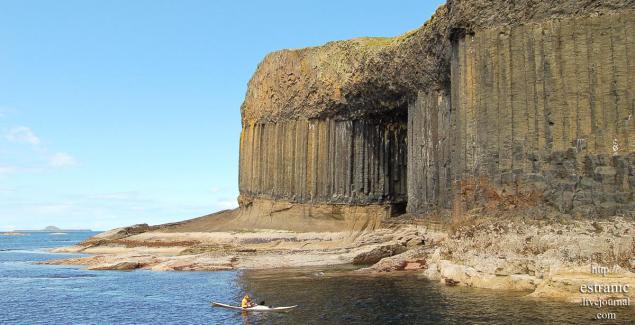
4. On the right side of the cave - the end of the only paths in the whole island. 99% reduce their sailing experience of the island to the passage path. The remaining 1% for some reason, climbs the steep cliff on the steep climb to the top of the island is flat and meaningless haunting surroundings. Fooling the most of the surrounding area can be less than an hour: the circumference of the island - less than 4 km. However, the meaning of zero in this action: all aliens disguised reliably and even beautiful views from the top - at least. However, if you wander particularly concentrated, then sooner or later your perseverance will be rewarded and you almost fall through the belt in grass camouflaged only on the island of the source of fresh water. Do not go on one.

5. Fingal's Cave - 20 meters high and 70 meters long. Basalt columns that form the cave, extremely durable. And it is extremely slippery - what I am personally convinced, nearly drowning while camera.
Meanwhile, before the cave got its latest "traumatic" name, it was called Ouham-Binn - "melodious cave". It really is quite extraordinary acoustics, and rolled into the depths of the cave waves create a whimsical, with nothing comparable sounds. Felix Mendelssohn, who visited the cave in 1829, was so impressed with sonorous breathing of the cave, he wrote his quite unearthly sounding overture "hybrids" (or "Fingal's Cave"). After the European triumph "Hybrid" Staffa suddenly became famous: it was visited by Jules Verne and John Keats, Lord Tennyson Turner and David Livingstone and Robert Lewis Stevenson, Sir Walter Scott, and even Queen Victoria to Prince Albert. Alice Liddell - the prototype of the girl Alice from "Wonderland" also pay a visit to the island, which is symbolic: a magical place in the UK still need to search. However, all these famous come in large numbers, fortunately, did not make the island the next tourist paradise: getting there was still difficult - and very expensive.

6.

7. This is a "shepherd" - a bundle of basalt columns, visible only at full tide. Who it is sterezhёt Shepherd - remains a mystery. Until the late 18th century on the island miraculously survived three deer, which are later replaced by a goat and a goat, and when, the mother of the climate, swam to the mainland, the monks from Iona were brought here a small but close-knit team of sheep. Sheep, however, are not delayed, and the last two centuries Staffa fully provided gulls, cormorants and other birds unpretentious animals.

8. Although the residents do not have to stuff (time, too, is not), the island as everything within the influence of Britain, certainly is privately owned and is often passed from hand to hand. Finally, in 1986, the year of its last owner, named Jock Elliot Jr., American (and where do without them), gave the island to the National Trust for Scotland as a gift for the 60th anniversary of his wife. And while you're looking at this act of cause and effect, adding that in return the grateful Foundation awarded 60-year-old former owner of the island the title of "Honorary keepers stuff." So currently equivalent exchange, right? However, I personally suspect that the eccentric Yankees just got rid of unprofitable property on which the local Conservative government as always inappropriately increased the land tax.

9. According to the legend, the giant Fingal - in his spare time, interplanetary flights, naturally - built from hexagonal pillars great way to Ireland. Remains of giant constructions of this road is still sticking out of the water in some places. What do you think, too, that the runway?

10.

11. Who said that all the newcomers - certainly humanoids?

12. Who said that all aliens must be a mammal?

McKinnon 13. Cave, named after one of the abbots from the island of Iona. With a length of about 107 meters of the cave is among the hundred largest sea caves in the world. To get inside, fortunately for the cave is possible only on a kayak or swim.
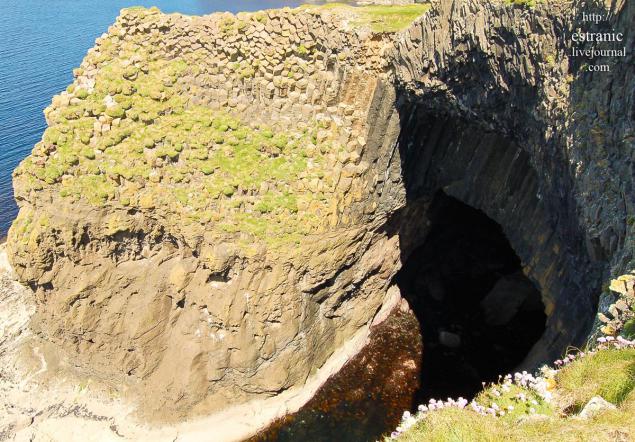
14. One of the few points on the island, facing to climb on it. Descend down to view the bizarre coastline, I do not recommend: the tide is happening faster than some tourists have time to climb on the rocks near the saving

15.

16. I have several of my friends architects, occasionally ugly whining about the lack of professionalism in modern construction. I hasten to assure you this photograph: if you follow my version, the problem of construction schlock much broader than our planet. If you do not adhere to - perhaps, the very nature against excessive correctness and symmetry?
Isle of Staffa. The right-cave - home of Fingal. Wild, fascinating place. Unearthly.
via
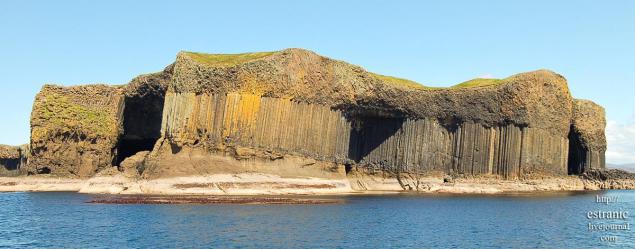
Source:
Staffa (translated from the Norse "island of the columns") - a volcanic island in the inner Hybrid.
For the general public stuff "discovered" in the 18th century, the famous naturalist, botanist and social activist Sir Joseph Banks, who compared the island basalt columns with the Louvre in Paris and Rome Cathedral of St. Peter - and not in favor of the latter.
Modern Britain is rightly took stuff in the top ten most beautiful places in the UK.
And I, in turn, am quite sure that this is an alien base which aliens do not even bother to disguise as it should. But judge for yourself.

2. Base aliens positioned very strategically: ten kilometers from the large neighboring island Mule. On the one hand - close to the populated areas, if you suddenly want to take a walk around the shops. On the other - it is still 10 km away from the sea of the rolled routes. Even today, the island is only accessible by a calm sea - what happens in these parts very often. Throw invariably hideous weather, squally winds with gusts to 100 km / h and the lack of places for berthing. It is not surprising that the last inhabitants fled the island already in the 18th century: it is difficult to live permanently on the land the size of a nickle some 30 hectares, which does not cease roar starters plates absent himself from which you can, at best, a couple of months a year.
In the absence of the local population aliens built wide: from the base of a dozen entrances, disguised as a cave. The most famous of them - Fingal's Cave, so named not only because visitors often slips in it (which is also true), but in honor of the giant Fingal (which is probably also not in vain so named), the hero gellskogo and Irish epic. Fingal's Cave (pictured below) - the only one to which few visitors to the island can be reached on foot along a narrow path of the broken off hexagonal pillars (pictured above). The remaining Pesher available only with water.

3. Kayak - the best way to explore the stuff. Some 10 km one way - and all the wonders of the cave belong only to you. Home - podgadat weather, which are easily changed with a sun in the storm and back in a mere half an hour.

4. On the right side of the cave - the end of the only paths in the whole island. 99% reduce their sailing experience of the island to the passage path. The remaining 1% for some reason, climbs the steep cliff on the steep climb to the top of the island is flat and meaningless haunting surroundings. Fooling the most of the surrounding area can be less than an hour: the circumference of the island - less than 4 km. However, the meaning of zero in this action: all aliens disguised reliably and even beautiful views from the top - at least. However, if you wander particularly concentrated, then sooner or later your perseverance will be rewarded and you almost fall through the belt in grass camouflaged only on the island of the source of fresh water. Do not go on one.

5. Fingal's Cave - 20 meters high and 70 meters long. Basalt columns that form the cave, extremely durable. And it is extremely slippery - what I am personally convinced, nearly drowning while camera.
Meanwhile, before the cave got its latest "traumatic" name, it was called Ouham-Binn - "melodious cave". It really is quite extraordinary acoustics, and rolled into the depths of the cave waves create a whimsical, with nothing comparable sounds. Felix Mendelssohn, who visited the cave in 1829, was so impressed with sonorous breathing of the cave, he wrote his quite unearthly sounding overture "hybrids" (or "Fingal's Cave"). After the European triumph "Hybrid" Staffa suddenly became famous: it was visited by Jules Verne and John Keats, Lord Tennyson Turner and David Livingstone and Robert Lewis Stevenson, Sir Walter Scott, and even Queen Victoria to Prince Albert. Alice Liddell - the prototype of the girl Alice from "Wonderland" also pay a visit to the island, which is symbolic: a magical place in the UK still need to search. However, all these famous come in large numbers, fortunately, did not make the island the next tourist paradise: getting there was still difficult - and very expensive.

6.

7. This is a "shepherd" - a bundle of basalt columns, visible only at full tide. Who it is sterezhёt Shepherd - remains a mystery. Until the late 18th century on the island miraculously survived three deer, which are later replaced by a goat and a goat, and when, the mother of the climate, swam to the mainland, the monks from Iona were brought here a small but close-knit team of sheep. Sheep, however, are not delayed, and the last two centuries Staffa fully provided gulls, cormorants and other birds unpretentious animals.

8. Although the residents do not have to stuff (time, too, is not), the island as everything within the influence of Britain, certainly is privately owned and is often passed from hand to hand. Finally, in 1986, the year of its last owner, named Jock Elliot Jr., American (and where do without them), gave the island to the National Trust for Scotland as a gift for the 60th anniversary of his wife. And while you're looking at this act of cause and effect, adding that in return the grateful Foundation awarded 60-year-old former owner of the island the title of "Honorary keepers stuff." So currently equivalent exchange, right? However, I personally suspect that the eccentric Yankees just got rid of unprofitable property on which the local Conservative government as always inappropriately increased the land tax.

9. According to the legend, the giant Fingal - in his spare time, interplanetary flights, naturally - built from hexagonal pillars great way to Ireland. Remains of giant constructions of this road is still sticking out of the water in some places. What do you think, too, that the runway?

10.

11. Who said that all the newcomers - certainly humanoids?

12. Who said that all aliens must be a mammal?

McKinnon 13. Cave, named after one of the abbots from the island of Iona. With a length of about 107 meters of the cave is among the hundred largest sea caves in the world. To get inside, fortunately for the cave is possible only on a kayak or swim.

14. One of the few points on the island, facing to climb on it. Descend down to view the bizarre coastline, I do not recommend: the tide is happening faster than some tourists have time to climb on the rocks near the saving

15.

16. I have several of my friends architects, occasionally ugly whining about the lack of professionalism in modern construction. I hasten to assure you this photograph: if you follow my version, the problem of construction schlock much broader than our planet. If you do not adhere to - perhaps, the very nature against excessive correctness and symmetry?
Isle of Staffa. The right-cave - home of Fingal. Wild, fascinating place. Unearthly.
via

Source:




